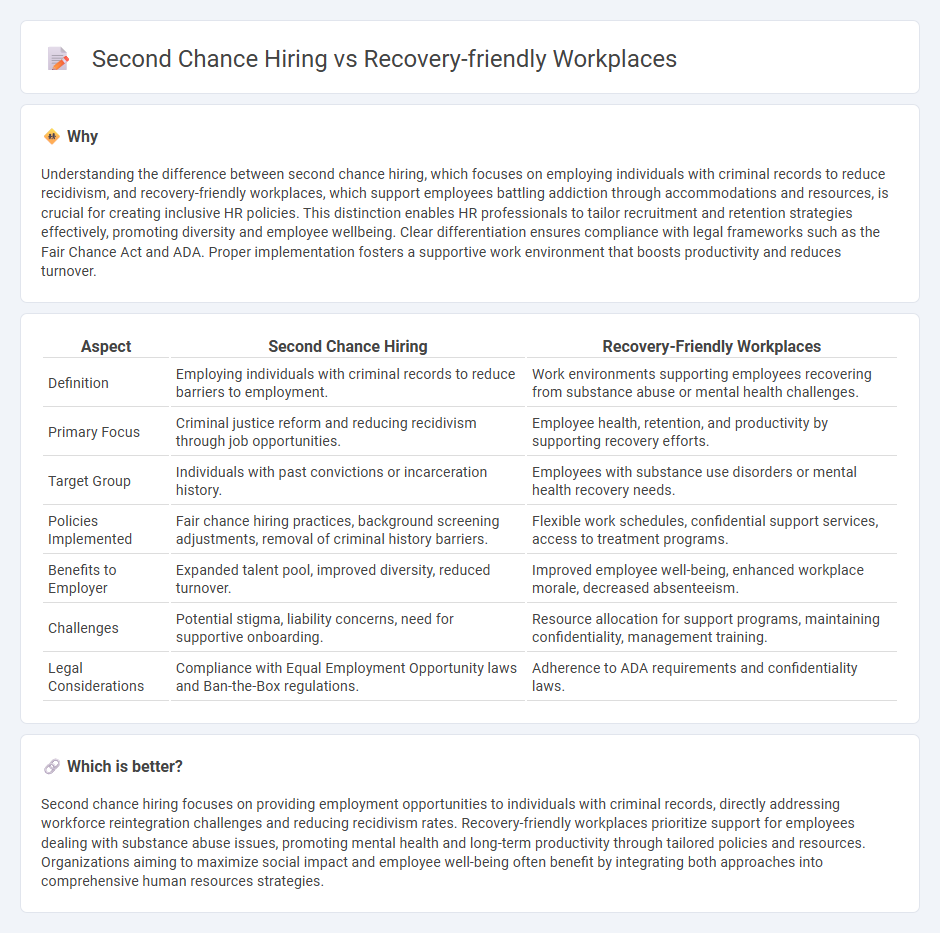
Second chance hiring focuses on employing individuals with criminal records to reduce recidivism and promote workforce reintegration, while recovery-friendly workplaces prioritize support systems enabling employees to overcome substance use challenges without fear of stigma or job loss. Both approaches enhance diversity, reduce turnover, and foster inclusive company cultures by addressing barriers to employment for marginalized groups. Discover more about how implementing these strategies can transform your human resources practices and improve organizational resilience.
Why it is important
Understanding the difference between second chance hiring, which focuses on employing individuals with criminal records to reduce recidivism, and recovery-friendly workplaces, which support employees battling addiction through accommodations and resources, is crucial for creating inclusive HR policies. This distinction enables HR professionals to tailor recruitment and retention strategies effectively, promoting diversity and employee wellbeing. Clear differentiation ensures compliance with legal frameworks such as the Fair Chance Act and ADA. Proper implementation fosters a supportive work environment that boosts productivity and reduces turnover.
Comparison Table
| Aspect | Second Chance Hiring | Recovery-Friendly Workplaces |
|---|---|---|
| Definition | Employing individuals with criminal records to reduce barriers to employment. | Work environments supporting employees recovering from substance abuse or mental health challenges. |
| Primary Focus | Criminal justice reform and reducing recidivism through job opportunities. | Employee health, retention, and productivity by supporting recovery efforts. |
| Target Group | Individuals with past convictions or incarceration history. | Employees with substance use disorders or mental health recovery needs. |
| Policies Implemented | Fair chance hiring practices, background screening adjustments, removal of criminal history barriers. | Flexible work schedules, confidential support services, access to treatment programs. |
| Benefits to Employer | Expanded talent pool, improved diversity, reduced turnover. | Improved employee well-being, enhanced workplace morale, decreased absenteeism. |
| Challenges | Potential stigma, liability concerns, need for supportive onboarding. | Resource allocation for support programs, maintaining confidentiality, management training. |
| Legal Considerations | Compliance with Equal Employment Opportunity laws and Ban-the-Box regulations. | Adherence to ADA requirements and confidentiality laws. |
Which is better?
Second chance hiring focuses on providing employment opportunities to individuals with criminal records, directly addressing workforce reintegration challenges and reducing recidivism rates. Recovery-friendly workplaces prioritize support for employees dealing with substance abuse issues, promoting mental health and long-term productivity through tailored policies and resources. Organizations aiming to maximize social impact and employee well-being often benefit by integrating both approaches into comprehensive human resources strategies.
Connection
Second chance hiring policies and recovery-friendly workplaces both support individuals overcoming addiction or criminal records by providing stable employment opportunities. These approaches reduce recidivism and enhance workforce diversity by promoting inclusive hiring practices that value personal rehabilitation and recovery journeys. Employers adopting these strategies benefit from increased retention rates and a more resilient, motivated workforce.
Key Terms
**Recovery-Friendly Workplaces:**
Recovery-friendly workplaces support employees overcoming substance use disorders by offering flexible schedules, confidential access to treatment resources, and stigma-free policies that promote sustained recovery. These workplaces often implement training programs to educate staff on addiction issues, fostering a culture of empathy and inclusion. Discover how adopting recovery-friendly workplace practices can enhance employee well-being and productivity.
Substance Use Disorder Support
Recovery-friendly workplaces prioritize creating supportive environments that accommodate employees managing substance use disorder (SUD) through flexible policies, stigma reduction, and access to treatment resources. Second chance hiring focuses on providing employment opportunities to individuals with a history of substance-related offenses or incarceration, aiming to reduce recidivism and promote reintegration. Explore how organizations implement these strategies to enhance SUD support and workforce inclusivity.
Workplace Wellness Programs
Recovery-friendly workplaces integrate workplace wellness programs that support employees facing substance use challenges by offering resources like counseling, peer support groups, and flexible leave policies. Second chance hiring emphasizes recruiting individuals with past criminal records, often incorporating tailored wellness initiatives to aid their successful reintegration and reduce recidivism. Explore how these strategies create inclusive work environments promoting health, productivity, and social equity.
Source and External Links
Recovery Supportive Workplaces - Recovery-friendly workplaces actively support employees in recovery from substance use disorder by adopting holistic, supportive policies and moving away from punitive zero-tolerance approaches, while maintaining a safe work environment.
National Recovery Friendly Workplace Institute - The National Recovery Friendly Workplace Institute promotes workplaces where employers and employees collaborate to create a culture and environment that continuously supports employees affected by substance use disorders, in line with national goals for a recovery-friendly nation.
Recovery Friendly Workplaces | Colorado Consortium - These organizations use evidence-based practices to recognize recovery as a strength, foster a healthy and safe workplace, and provide education and resources to support employees in treatment and recovery.
 dowidth.com
dowidth.com